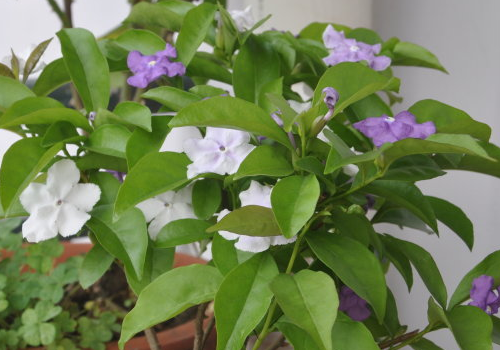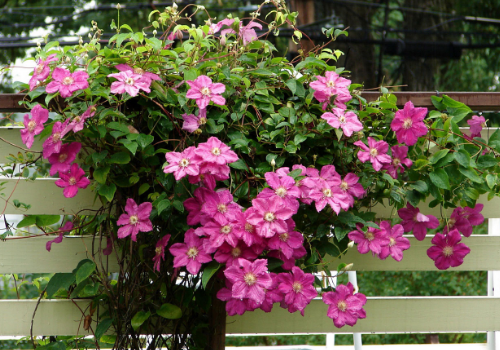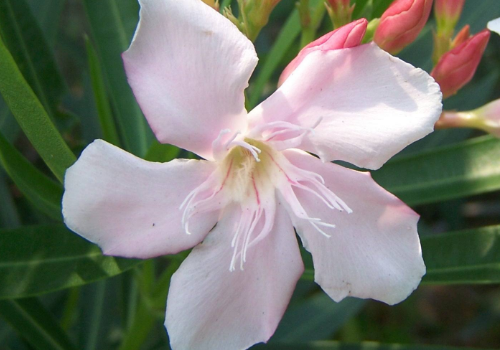How to reproduce and prune two-color jasmine
From a realistic point of view, people planting plants is no longer what plants can provide for us, but people take more care of plants, which is a kind of harmony between man and nature, and at the same time, after the material is rich, the improvement of aesthetic sentiment. How do you reproduce that pair of jasmine? How to trim bicolor jasmine?
How to reproduce bicolor jasmine:
1. Sowing and propagation of bicolor jasmine
Sowing and reproduction is a common way for bicolor jasmine to reproduce. First of all, select the right seeds, sterilize and germinate, sow them into the soil, cover them with soil about twice the size of the seeds, and then spray the soil with moisture.
After that, you need to slowly wait for the plant to sprout and grow roots, pay attention to keep the soil moist, keep the low temperature warm in winter, and wrap the flowerpot in a plastic bag.
2. Cutting propagation of two-color jasmine.
Two-color jasmine in cutting, generally choose the way of softwood cutting, between late spring and early autumn, choose the branches of the same year as cuttings, hardwood cuttings generally choose the branches of the previous year as cuttings in early spring.
Coarse sand can be used as substrate when cutting, and two-color jasmine can be cut after cleaning.
3. Striping propagation of bicolor jasmine
Striping is also a common way of propagation of two-color jasmine. When making striping, choose the strong-growing branches, peel off the outer skin from the top of the branches about 30cm, and use the ring peeling method.
After peeling off the skin, wrap the wound in a plastic film and add some moist soil. Pay attention to the insertion of the upper and lower ends, and wait for it to take root slowly, which will take about 6 weeks.

How to trim bicolor jasmine:
The specific pruning methods are different because the straight plant type of the plant is different. But generally speaking, the principle of pruning is to keep the plant under low pressure, promote the germination of new branches and blossom more. The old branches were truncated and renewed. The common practices are:
After flowering, cut short the flowering branches and cut off some longer branches to promote the germination of new branches. In addition, cut off the remaining flowers in time after the flower fade, so as to avoid the withered leaves staying on the branches for too long, affecting the beauty. In short, the principle of pruning after flowering is to ensure that the plant is compact and beautiful, and proper pruning can promote flowering in the next half of the month.
Heavy pruning should be carried out before the beginning of winter, with 2 or 3 buds in each branch, all the rest cut off, and the thin branches, diseases and insect pests cut off, as long as they do not become bald, everyone can rest assured to prune. After pruning, the light transmittance is enhanced, which is conducive to the growth and blooming of bicolor flowers in the spring of the coming year.
You know how to make bicolor jasmine reproduce.
How to prune two-color jasmine and how to breed it
Two-color jasmine this plant is real, itself is a kind of horse tooth plant, can be regarded as a relatively special species. Two-color jasmine is described most of the time is more delicate, two-color jasmine plants are also very rare, leaves will also change color. Today, I would like to introduce to you the cultivation of two-color jasmine and see how to prune it.
How to trim two-color jasmine
First, how to trim two-color jasmine-- blossom
Many people literally think that bicolor jasmine will not blossom, only branches and leaves. But in fact, two-color jasmine will blossom, if you can buy when you can buy already flowering is even better. The flowers of bicolor jasmine are small red flowers, which are particularly beautiful in the green leaves. If you have not seen the flowers of bicolor jasmine, it can only mean that they have not been planted.
2. How to prune and reproduce bicolor jasmine
Bicolor jasmine is a plant that can be cutted. choose to use sturdy branches for cutting treatment, cut off all leaves except the top leaves, and plant them in the soil when dry. The soil prepared with rotten leaf soil and coarse sand can have good water permeability and will not accumulate water and is suitable for two-color jasmine.
Third, how to prune and fertilize two-color jasmine
Two-color jasmine should not be treated with fertilizer in the first two months after planting, but it is also possible to apply fertilizer after the root system of two-color jasmine is fully grown. Two-color jasmine can be fertilized every ten days or so at a suitable fertilization stage. Two-color jasmine has strong vitality and is suitable for beginners to grow.
How to prune two-color jasmine Culture methods and matters needing attention of two-color jasmine
Two-color jasmine, also known as mandarin duck jasmine, five-color jasmine, pan jasmine. Do you know anything about it? Today we are going to tell you how to trim two-color jasmine and how to cultivate two-color jasmine.
Culture methods of two-color jasmine:
Soil: two-color jasmine is generally cultivated in East China and North China, and likes the slightly acidic soil with good drainage and air permeability.
Temperature: the most suitable growth temperature of two-color jasmine is between 20 and 30 ℃. It enters the dormant period under the condition of 12 ℃ and is not resistant to cold. Pay attention to adjust the room temperature in winter.
Lighting: two-color jasmine likes a sunny, warm and humid climate, afraid of hot sun exposure, pay attention to shading in summer, and shine at least four hours a day, so as to ensure the quantity and quality of flowering.
Watering: two-color jasmine like wet, but afraid of waterlogging, watering principle "see dry see wet". In summer, we should not only fully water, but also keep the air moist, spray the leaves with clean water 2 or 3 times a day, and keep the basin soil dry in winter to prevent frostbite.
Fertilization: after the two-color jasmine flower fade, the thin cake fertilizer was applied once, and the liquid fertilizer mainly composed of phosphorus and potassium was applied once after 10 days, and 0.2% potassium dihydrogen phosphate was sprayed on the leaf surface combined with watering to promote flower bud differentiation. In addition, it is necessary to apply secondary thin alum fertilizer and water during the growing period to prevent soil alkalinization and leaf yellowing.
Pest control: in the red spider damage period, 40% omethoate 1000-1500 times liquid spray can be used to control.
Pruning: cut off the residual flowers after the flower fade, cut off some long branches, cut off the weak branches, introverted branches, disease and insect branches at the end of autumn, to ensure the growth of two-color jasmine in the coming year.
Points for attention in two-color jasmine culture:
1. Two-color jasmine likes warm, humid climate and is not resistant to cold. Acid loam with sufficient sunshine and good drainage is required. You need to spend the winter indoors in winter and move outside in spring.
2. The cultivation soil can be used garden soil: rotten leaf soil: Rice chaff ash (1.5 / 1 / 1 / 0.5), properly mixed with barnyard manure. Prune properly when turning the basin in spring, trimming off old roots, withered branches, dense branches and long branches. It needs to be cultivated under a big tree in summer.
3. The amount of water can be gradually increased after spring, and can be watered once every 2 days in summer. Properly spray water on the leaf surface and the surrounding environment to reduce the number of watering in autumn. In winter, it is usually watered once every 10 days, and too much watering will lead to fallen leaves or root rot.
4. Apply pancake fertilizer and water (20%) every 10 to 15 days in spring and summer, and stop fertilization in autumn to prevent new shoots from freezing damage.
How to trim bicolor jasmine
The specific pruning methods vary from plant to plant, but generally speaking, the pruning principle is to reduce the plant height, make it produce more new branches, blossom more, and renew the old branches. generally speaking, it is to truncate the flowering branches after flowering, cut off the residual flowers after each flower fade, and cut off some long branches to make them sprout more branches, make the tree compact and beautiful, so as to blossom more next month, and after the last blossom at the end of autumn. Heavy pruning, that is, leaving 2-3 buds per branch, cutting off the rest, and cutting off the thin branches, introverted branches, disease and insect branches, in order to grow vigorously in spring next year, and the branch crown two-color jasmine blossoms.
- Prev

What is the method of breeding clematis?
But some plants are not suitable for indoor cultivation, you know? Is clematis poisonous? What is the method of cultivation? Clematis is poisonous: clematis is not poisonous. It has a certain ornamental value, in addition, it also has medicinal value. Clematis can be used medicinally to treat many diseases
- Next

How to plant oleander and how to control diseases and insect pests
Oleander is a flower that likes fertilizer and water, neutral or slightly acidic soil. How do you grow oleander? How to prevent and cure oleander diseases and pests? How to plant oleander: pruning, the top branch of oleander has the characteristic of one-third, which can be trimmed and shaped according to the need. If you need a trigeminal nine-top shape, you can cut off a part at the top of the trigeminal.
Related
- Fuxing push coffee new agricultural production and marketing class: lack of small-scale processing plants
- Jujube rice field leisure farm deep ploughing Yilan for five years to create a space for organic food and play
- Nongyu Farm-A trial of organic papaya for brave women with advanced technology
- Four points for attention in the prevention and control of diseases and insect pests of edible fungi
- How to add nutrient solution to Edible Fungi
- Is there any good way to control edible fungus mites?
- Open Inoculation Technology of Edible Fungi
- Is there any clever way to use fertilizer for edible fungus in winter?
- What agents are used to kill the pathogens of edible fungi in the mushroom shed?
- Rapid drying of Edible Fungi

